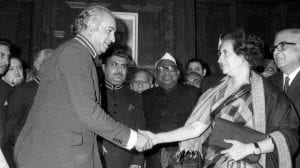
Indian Prime Minister Indira Gandhi (right) and Pakistani President Zulfikar Ali Bhutto (left) shake hands following the signing of the Simla Agreement, 1972.
Volume V – Number 1
Charles H. Heimsath
Abstract: Throughout the 1950s and 1960s, the south Asian region of the world has presented very few crisis situations for American foreign policy. This era of relative peace in south Asia can be attributed to the area’s political stability as well as India’s non-aggressive, non-nuclear military agenda. However, lacking significant and enduring threats to American interests, it is possible that south Asia may slip to the background of American foreign policy. On the contrary, this article proposes that countries in south Asia, particularly those that are experiencing large population growth such as India and Pakistan, are an ideal focus for the United State’s international economic policy. The rapid population growth of these countries is likely to have a negative impact on gross national income growth, living standards, and purchasing power in the region, which could cause these states to become aggressive towards countries that are complacent and content to perpetuate the status quo. This article argues that United States foreign policy for the 1970s should develop beneficial economic relationships with south Asian countries to counter-act the possibility of economic suffering in the region from leading to international instability and aggression.
Keywords: India, Pakistan, population growth, foreign policy, south Asia, stability, economics



You must be logged in to post a comment.